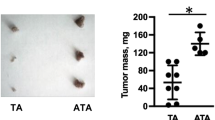Abstract
Background
The progressive growth of tumors in mice is accompanied by down-regulation of specific T cell responses. The factors involved in this suppression are not completely understood. Here, we have developed a model to examine the role of host immune effector cells in the inhibition of T cell function. In this model, progressive growth of a colon carcinoma line, CT26, is accompanied by loss of T cell response to alloantigens in both cytolytic and proliferation assays.
Materials and Methods
The CT26 tumor was inoculated into BALB/c syngeneic mice. Tumor growth, cytolytic T cell responses, lymphocyte proliferation, and flow cytometric analysis was performed in tumor-bearing animals 7 or 28 days after tumor inoculation.
Results
Spleen cells from tumor-bearing mice were found to suppress the proliferative response of spleen cells from normal mice to alloantigens. Examination of the spleen cell population by FACS analysis revealed an increase in the percentage of monocytes as defined by expression of CD1 1b, the Mac-1 antigen. Removal of the Mac-1-positive cells from the tumor-bearing hosts spleen relieved suppression of the tumor-bearing mouse spleen cell proliferative response to alloantigens, and addition of the Mac-1-positive enriched cells suppressed proliferation of normal T cells in response to alloantigens. Cell contact was required for this inhibition.
Conclusions
Tumor induction of suppressive monocytes plays an important role in the general immunosuppression noted in animals bearing CT26 tumors. Identification of the mechanisms responsible for this effect and reversal of tumor-induced macrophage suppression may facilitate efforts to develop effective immunotherapy for malignancy.






Similar content being viewed by others
References
Broder S, Waldmann TA. (1978) The suppressor network in cancer. N. Engl. J. Med. 299: 1281–1284.
Deckers PJ, Davis RC, Parker GA, Mannick JA. (1973) The effect of tumor size on concomitant tumor immunity. Cancer Res. 33: 139.
Maccubbin DL, Mace KF, Ehrke MJ, Mihich E. (1989) Modification of host antitumor defense mechanisms in mice by progressively growing tumor. Cancer Res. 49: 4216–4224.
North RJ, Bursuker I. (1984) Generation and decay of the immune response to a progressive fibrosarcoma. J. Exp. Med. 159: 1312–1321.
Janeway CA, Golstein P. (1993) Lymphocyte activation and effector functions. Curr. Opin. Immunol. 5: 313–323.
Weiss A. (1993) T cell antigen receptor signal transduction: A tale of tails and cytoplasmic protein-tyrosine kinases. Cell 73: 209–212.
Weiss A, Littman DR. (1994) Signal transduction by lymphocyte antigen receptors. Cell 76: 263–274.
Tada T, Ohzeki S, Utsumi K, et al. (1991) Transforming growth factor-β-induced inhibition of T cell function. J. Immunol. 146: 1077–1082.
Young RM, Wright MA, Coogan M, Young ME, Bagash J. (1992) Tumor-derived cytokines induce bone marrow suppressor cells that mediate immunosuppression through transforming growth factor β. Cancer Immunol. Immunother. 35: 14–18.
Malick AP, Garner R, Black SP, Elgert KD. (1984) Normal and tumor-bearing host macrophage factor-mediated modulation of mixed-lymphocyte reaction responsiveness: Separation of T-lymphocyte subset susceptibility to enhancing and inhibitory factors. Cell. Immunol. 85: 11.
Walker TM, Burger CJ, Elgert KD. (1994) Tumor growth alters T cell and macrophage production of and responsiveness to granulocyte-macrophage colony-stimulating factor: Partial dysregulation through interleukin-10. Cell. Immunol. 154: 342–357.
Fu Y, Watson G, Jimenez JJ, Wang Y, Lopez DM. (1990) Expansion of immunoregulatory macrophages by granulocyte-macrophage colony-stimulating factor derived from a murine mammary tumor. Cancer Res. 50: 227–234.
Parhar RS, Lala PK. (1988) Prostaglandin E2-mediated inactivation of various killer lineage cells by tumor-bearing host macrophages. J. Leukoc. Biol. 44: 474–484.
Watson GA, Fu Y, Lopez DM. (1991) Splenic macrophages from tumor-bearing mice co-expressing MAC-1 and MAC-2 antigens exert immunoregulatory functions via two distinct mechanisms. J. Leukoc. Biol. 49: 126–138.
Aoe T, Okamoto Y, Saito T. (1995) Activated macrophages induce structural abnormalities of the T cell receptor-CD3 complex. J. Exp. Med. 181: 1881–1886.
Plautz GE, Yang Z, Wu B, Gao X, Huang L, Nabel GJ. (1993) Immunotherapy of malignancy by in vivo gene transfer into tumors. Proc. Natl. Acad. Sci. U.S.A. 90: 4645–4649.
Fernandez-Cruz E, Gilman SC, Feldman JD. (1982) Altered levels of mononuclear leukocytes in tumor-bearing rats: decrease of helper T lymphocytes and increase of suppressor cells. J. Immunol. 129: 1324–1328.
Mizoguchi H, O’Shea JJ, Longo DL, Loeffler CM, McVicar DW, Ochoa AC. (1992) Alterations in signal transduction molecules in T lymphocytes from tumor-bearing mice. Science 258: 1795–1798.
Smith DR, Kunkel SL, Burdick MD, et al. (1994) Production of interleukin-10 by human bronchogenic carcinoma. Am. J. Pathol. 145: 18–25.
Howard M, O’Garra A. (1992) Biological properties of interleukin 10. Immunol. Today 13: 198–200.
Ko-Huang L, Lauener RP, Winchester RJ, Geha RS, Vercelli D. (1991) Engagement of CD14 on human monocytes terminates T cell proliferation by delivering a negative signal to T cells. J. Immunol. 147: 1134–1138.
Stach RM, Rowley DA. (1993) A first or dominant immunization, II Induced immunoglobulin carries transforming growth factor β and suppresses cytolytic T cell responses to unrelated alloantigens. J. Exp. Med. 178: 841–852.
Denham S, Rowland IJ. (1992) Inhibition of the reactive proliferation of lymphocytes by activated macrophages: The role of nitric oxide. Clin. Exp. Immunol. 87: 157–162.
Acknowledgments
We would like to thank Donna Gschwend for secretarial assistance, Karen Carter for preparation of figures, Judy Stein for help in figure preparation and statistical analysis, and Dr. Keith Bishop for helpful advice and discussion. This work was supported in part by a grant from the National Institutes of Health (P01 CA59327-01; NIH).
Author information
Authors and Affiliations
Rights and permissions
About this article
Cite this article
Jaffe, M.L., Arai, H. & Nabel, G.J. Mechanisms of Tumor-Induced Immunosuppression: Evidence for Contact-Dependent T Cell Suppression by Monocytes. Mol Med 2, 692–701 (1996). https://doi.org/10.1007/BF03401653
Accepted:
Published:
Issue Date:
DOI: https://doi.org/10.1007/BF03401653




